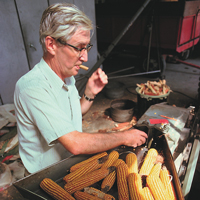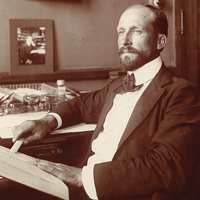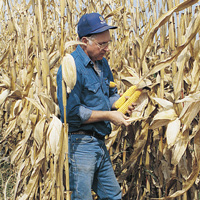A Tradition of Excellence
Since 1867, the University of Illinois-located in the heart of America's Corn
Belt-has earned a reputation as one of the premier educational and research institutions
in the world. Its distinguished College of Agricultural, Consumer and Environmental
Sciences ranks among the 10 best in the United States, due in part to world-renowned
achievements relating to maize (corn) breeding and genetic research.
Scientists of the college's Maize Breeding & Genetics Laboratory seek to accomplish
three important goals:
- improve the grain yield and value-added traits of corn;
- improve the agronomic characteristics of corn, including resistance to disease;
and
- provide educational opportunities for students that prepare them for careers in plant breeding, genetics and pathology.

Faculty, students and alumni of the University of Illinois have been fundamental in creating the scientific foundation for corn breeding, genetics and pathology. Agronomists at the University began inbreeding maize in 1889. These genetic constructs were used by E.M. East, a UI alumnus at the Connecticut Agricultural Experiment Station, to demonstrate hybrid vigor, the scientific basis for hybrid corn. Illinois was an early leader in the development of double-cross hybrids, including the development of Hy2, one of the inbred lines in a historical double-cross hybrid.


The University of Illinois is well known for experiments selecting for protein and oil. In 1896, Cyril Hopkins started what has become the longest continuous directed-selection experiment in the history of higher plant science. It still continues today, enhanced by advanced analytical techniques such as nuclear magnetic resonance spectroscopy (pioneered by D.E. Alexander). The result of that work, high-oil corn, is now an integral part of agriculture.
In the early 1950s, J.R. Laughnan identified a gene responsible for high sugar characteristics in kernels, which eventually led to the development of "super sweet" sweet corn hybrids. Another high sugar type of sweet corn, sugary enhancer, was the product of A.M. Rhodes's research in the 1970s. These two types of sweet corn now dominate the fresh sweet corn market.
The close association between corn breeders and pathologists at the University of Illinois dates back to the earliest studies of corn diseases and host resistance. In a 1924 bulletin co-written by plant breeders and pathologists, the authors stated: "The greatest improvement in resistance and productivity may be expected to accrue from the continuous practice of plant selection."

The University's tradition of breeding for disease resistance has continued throughout the century. Led by A.L. Hooker, university scientists helped prevent even greater losses to southern corn leaf blight in the early 1970s by identifying the susceptibility of cytoplasm male sterile-T. Most of the disease resistance found in sweet corn and much in dent corn was identified or incorporated into elite materials at the University of Illinois.
The Maize Breeding & Genetics Laboratory is unique in its emphasis on grain quality and disease resistance-simply put, no one else does what we do. Our success stems from the wide-ranging expertise of our scientists, who are leaders of their individual fields and cooperative members of a cohesive team. This balanced, cross-disciplinary approach allows us to provide a total package of theoretical research and practical application.